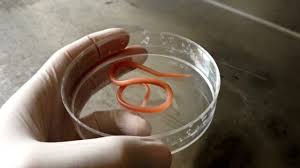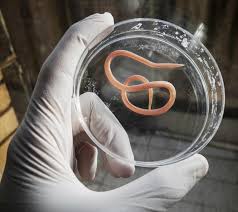Roundworms, scientifically known as nematodes, are fascinating creatures that inhabit diverse environments across the globe. These slender, unsegmented worms belong to the phylum Nematoda and are abundant in soil, water, and even inside other organisms. Despite their microscopic size, roundworms play crucial roles in ecosystems and can impact the health of plants, animals, and humans.
These tiny worms, typically ranging from 1 mm to 40 cm in length, have a cylindrical body with a protective cuticle. Unlike some other worms, roundworms lack a circulatory system, using their body fluids to transport nutrients. Their simple structure belies their significance in various ecological processes.
In the soil, nematodes contribute to nutrient cycling by breaking down organic matter. Some species are beneficial as they help decompose dead plants and animals, releasing essential nutrients into the soil. However, certain roundworms can be harmful, feeding on plant roots and causing damage to crops.
In aquatic environments, nematodes are integral to the food chain. They serve as prey for various organisms, contributing to the overall balance of aquatic ecosystems. Moreover, some roundworms have developed remarkable adaptations to survive extreme conditions, such as deep-sea environments where pressure is immense.
One unique aspect of roundworms is their versatility in parasitic relationships. While many nematodes are free-living, others are parasitic, infecting plants, animals, and humans. In humans, some parasitic roundworms can cause diseases like trichinellosis and ascariasis. These infections often occur through the ingestion of contaminated food or water.
Researchers study roundworms not only for their ecological roles but also for their biological simplicity. The nematode Caenorhabditis elegans, for instance, has become a model organism in scientific research due to its rapid reproduction and well-understood genetic makeup. Scientists use these worms to investigate various aspects of biology, from development to aging.
Understanding roundworms is crucial for agriculture, as certain species can threaten crop yields. Efforts are underway to develop sustainable methods for controlling parasitic nematodes without harming beneficial ones. Additionally, researchers explore the potential of nematodes in bioremediation, using them to clean up polluted environments.
However, roundworms, or nematodes, are small yet influential organisms that inhabit diverse habitats. Their impact on ecosystems, both positive and negative, underscores the need for continued research and conservation efforts. Whether contributing to nutrient cycling, serving as model organisms in laboratories, or posing challenges in agriculture, these unassuming worms play a significant role in the intricate web of life on Earth.
Read Also: Late Blight (Potato and Tomato): Description, Damages Caused, Control and Preventive Measures
Plants and Animals Affected by Roundworms (nematodes)

Roundworms, scientifically known as nematodes, can affect a wide range of plants and animals, exerting both positive and negative influences on their hosts. These microscopic organisms play diverse roles in ecosystems, impacting the health and well-being of various species.
Plants:
1. Crop Plants: Some nematode species can be detrimental to crop plants. They invade the roots, causing diseases like root knot nematode infestation. This can lead to stunted growth, reduced crop yield, and overall economic losses in agriculture.
2. Trees and Ornamental Plants: Nematodes are not limited to agricultural settings; they can also affect trees and ornamental plants. Root-feeding nematodes can weaken the root system, making plants susceptible to other stress factors.
3. Beneficial Plants: On the flip side, certain nematodes play a positive role in plant health. Beneficial nematodes, like those in the Steinernema and Heterorhabditis genera, can act as biological control agents by parasitizing harmful insects, protecting plants from pests.
Animals:
1. Livestock: Nematodes can have significant effects on livestock, causing diseases in animals such as cattle, sheep, and horses. Gastrointestinal nematodes, for example, can infect the digestive tract, leading to weight loss, decreased productivity, and, in severe cases, mortality.
2. Pets: Domestic animals like dogs and cats can also be susceptible to nematode infections. Heartworm, caused by a parasitic roundworm called Dirofilaria immitis, affects the cardiovascular system of dogs and can be fatal if left untreated.
3. Wildlife: Nematodes are pervasive in natural ecosystems, impacting a variety of wildlife species. Parasitic nematodes can infect birds, mammals, and reptiles, influencing population dynamics and ecosystem balance.
4. Aquatic Animals: Some nematodes thrive in aquatic environments and can affect fish and other aquatic organisms. These parasites may cause diseases in fish farms, impacting the aquaculture industry.
Understanding the interactions between nematodes and different plants and animals is crucial for effective pest management, agriculture, and conservation efforts. Researchers and practitioners strive to develop sustainable strategies to mitigate the negative impacts of harmful nematodes while harnessing the beneficial aspects for biological control and environmental restoration.
Damages Caused by Roundworms
Roundworms, scientifically known as nematodes, can cause various damages across different ecosystems, affecting plants, animals, and even humans. The impact of these microscopic worms ranges from agricultural losses to health issues, highlighting the importance of understanding and managing nematode infestations.
1. Agricultural Damages:
Crop Yield Reduction: Certain nematode species, like root-knot nematodes, invade the roots of plants, leading to the formation of galls and impairing the plant’s ability to absorb water and nutrients. This can result in stunted growth, decreased crop yield, and economic losses in agriculture.
Root Damage: Nematodes that feed on plant roots can cause extensive damage to the root system, weakening the overall structure of the plant. This makes the affected plants more susceptible to other stress factors, such as drought or other diseases.
Transmission of Plant Diseases: Some nematodes act as vectors for plant pathogens, transmitting viruses and other microorganisms that cause diseases. This can contribute to the spread of plant diseases and further impact crop health.
2. Livestock and Animal Damages:
Gastrointestinal Infections: Nematodes that infect the digestive tract of animals, such as gastrointestinal nematodes in livestock, can lead to weight loss, reduced feed efficiency, and overall decreased productivity. In severe cases, these infections may result in death.
Cardiopulmonary Diseases: Certain nematodes, like the heartworm in dogs, can cause serious cardiopulmonary diseases. Infestations may lead to coughing, exercise intolerance, and, if left untreated, can be fatal.
3. Human Health Impacts:
Parasitic Infections: Humans can also be affected by nematode parasites. Ingesting contaminated food or water can lead to parasitic infections, causing diseases such as ascariasis, trichinellosis, and filariasis. Symptoms may include abdominal pain, diarrhea, and in some cases, severe complications.
Nutrient Deprivation: In the case of intestinal nematode infections, the parasites may compete with the human host for nutrients, leading to malnutrition and other health issues.
Understanding the damages caused by roundworms is crucial for implementing effective control measures and developing strategies for sustainable agriculture and public health. Researchers continue to explore innovative approaches, including biological control methods and resistant plant varieties, to mitigate the negative impacts of nematodes on various ecosystems.
Read Also: Early Blight (Tomato): Description, Damages Caused, Control and Preventive Measures
Control and Preventive Measures

Controlling and preventing roundworm infestations involves a combination of integrated pest management strategies to minimize their impact on plants, animals, and humans. Here are some measures commonly employed:
1. Agricultural Practices:
Crop Rotation: Alternating crops in a field can disrupt the life cycle of nematodes, as different species may prefer specific host plants. This can help reduce nematode populations and minimize crop damage.
Cover Crops: Planting cover crops with natural resistance to nematodes or using certain crops that suppress nematode populations can be an effective strategy. These cover crops act as a barrier and help manage nematode numbers in the soil.
Soil Solarization: Exposing soil to high temperatures by covering it with transparent plastic during hot months can kill nematodes and their eggs. This practice, known as soil solarization, is especially effective in regions with intense sunlight.
Biological Control: Beneficial nematodes, fungi, and bacteria that are natural enemies of harmful nematodes can be introduced to the soil. These organisms act as biological control agents, keeping nematode populations in check.
2. Livestock Management:
Pasture Rotation: Rotating grazing areas for livestock can help break the life cycle of nematodes that affect animals. This reduces the risk of animals becoming infected with gastrointestinal nematodes.
Anthelmintic Treatments: Veterinary medications known as anthelmintics can be administered to livestock to control nematode infections. However, resistance to these drugs can develop, so their use should be carefully managed.
3. Human Health Measures:
Hygiene and Sanitation: Preventing human exposure to nematode infections involves practicing good hygiene, including thorough handwashing and proper food preparation to avoid ingesting contaminated food or water.
Public Health Education: Raising awareness about nematode-related diseases and promoting proper sanitation practices in communities can contribute to the prevention of parasitic infections in humans.
Medical Treatment: In cases of human infections, appropriate medical treatment, often involving anthelmintic medications, is essential. Seeking medical advice promptly is crucial for effective management.
It’s important to note that integrated pest management, combining various methods, is often more effective than relying on a single approach. Continuous monitoring, research into resistant crop varieties, and sustainable practices are key components of successful nematode control and prevention.
Frequently Asked Questions (FAQs) About Roundworms (nematodes)
Q1: What are roundworms?
A1: Roundworms, scientifically known as nematodes, are microscopic, unsegmented worms belonging to the phylum Nematoda. They inhabit diverse environments and can be free-living or parasitic.
Q2: Where are roundworms found?
A2: Roundworms are found in various habitats, including soil, water, and even inside other organisms. They are globally distributed and play roles in both terrestrial and aquatic ecosystems.
Q3: How do roundworms affect plants?
A3: Certain nematodes can be harmful to plants, invading their roots and causing diseases. This can lead to stunted growth, reduced crop yield, and economic losses in agriculture.
Q4: Do all roundworms harm plants and animals?
A4: No, while some nematodes can be harmful, others play beneficial roles. Some nematodes act as biological control agents, helping control pest populations in agriculture.
Q5: Can roundworms infect humans?
A5: Yes, certain nematodes can parasitize humans, causing diseases like ascariasis, trichinellosis, and filariasis. Infections often occur through the ingestion of contaminated food or water.
Q6: How can farmers control nematode damage to crops?
A6: Farmers can employ various strategies, including crop rotation, planting cover crops, using resistant plant varieties, and introducing beneficial nematodes or other biological control agents.
Q7: Are there treatments for nematode infections in animals?
A7: Yes, veterinary medications known as anthelmintics can be used to treat nematode infections in animals. However, careful management is required to prevent the development of drug resistance.
Q8: What is soil solarization, and how does it help control nematodes?
A8: Soil solarization involves covering soil with transparent plastic to expose it to high temperatures, effectively killing nematodes and their eggs. This practice is especially useful in regions with intense sunlight.
Q9: Can nematodes be used in scientific research?
A9: Yes, the nematode Caenorhabditis elegans, in particular, is a widely used model organism in scientific research. Its simple genetics and rapid reproduction make it valuable for studying various biological processes.
Q10: How can individuals prevent nematode infections?
A10: Practicing good hygiene, proper food preparation, and avoiding contaminated water can help prevent human exposure to nematode infections. Seeking medical advice promptly in case of symptoms is important for effective management.
Read Also: The Impact Of Hazardous Waste Disposal in Los Angeles

